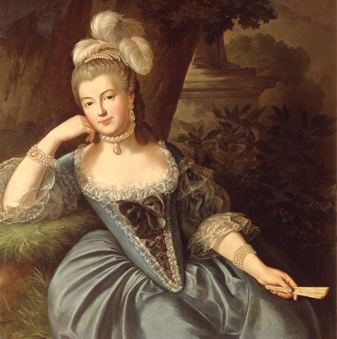Tenure 1757–1770 | Name Maria Brignole | |
 | ||
Issue Honore IV, Prince of MonacoPrince Joseph of Monaco Spouse Louis Joseph, Prince of Conde (m. 1798–1813), Honore III, Prince of Monaco (m. 1757–1770) Children Honore IV, Prince of Monaco, Prince Joseph of Monaco Parents Giuseppe Brignole, Maria Anna Balbi Grandchildren Florestan I, Prince of Monaco, Athenais Grimaldi, Honore V, Prince of Monaco Similar People Prince Joseph of Monaco, Louise Hippolyte - Princess, Florestan I - Prince of Monaco, Robert - Count of Clermont | ||
Maria Caterina Brignole (or Marie-Christine de Brignole; 7 October 1737 – 18 March 1813) was the daughter of a Genovese nobleman. On 5 June 1757 she married Honoré III, Prince of Monaco.
Contents
Her husband died in 1795, and in 1798 she married Louis Joseph de Bourbon, Prince de Condé, a French prince du sang.
Background
Maria Caterina was the daughter of Giuseppe Maria Brignole Sale, 7th Marchese di Groppoli, of a family whose members had occupied the position of doge in the Republic of Genoa, and Maria Anna Balbi, daughter of a doge of Genoa. As her father was the Genovese ambassador to France, Maria Caterina and her mother frequented the salons of Paris and the royal court of Versailles. Her biographer, Philippe Paul, comte de Ségur, called Maria Caterina "the most beautiful woman in France".
Maria Caterina fell in love with the Prince de Condé, Louis Joseph de Bourbon, In 1755, however, her mother proposed a marriage between Maria Caterina and her own former lover, Honoré III of Monaco.
The family wanted to raise its status and forestall a marriage for Honoré arranged by the French court and designed to further French influence in Monaco. Honoré had declined many marriage proposals but was willing to marry Maria Caterina because of her beauty and dowry and soon seduced her. Her father, however, disagreed because of the bad reputation of Prince Honoré as well as the prospect of the prince inheriting his fortune. He relented only after intervention by Louis XV and Madame de Pompadour, giving his consent in 1757.
Princess of Monaco
Maria Caterina came to Monaco by boat accompanied by a suite of the Genovese nobility. When they arrived, however, Prince Honoré did not come aboard the ship to welcome his bride. When they asked him to do so, he replied that his status as a monarch demanded that she come to him instead. The Genovese entourage answered that Maria Caterina was a member of a ruling family of the Republic of Genoa and refused to do so. The ship was therefore stranded offshore for several days, until the predicament was resolved by the couple meeting halfway on a bridge between the boat and the shore.
The relationship was at first amicable, and the couple had two sons, Honoré IV, Prince of Monaco (born 17 May 1758) and Prince Joseph (born in 1763). Maria Caterina lived in Matignon, where she spent her days with the Prince de Condé, and seldom took part in court life. Honoré became more and more jealous, and demanded that she write down her thoughts for him. Once, she was alone for several hours with a handsome nobleman, who helped her to open a cupboard which had been stuck. After this incident, the jealousy of her husband worsened to the point where it was no longer endurable.
In the meantime the Prince de Condé's wife, Charlotte de Rohan, whom he had married in 1753, died in 1760, and as time passed his relationship with Maria Caterina became more serious. By 1769 she had begun to set up a home in the Hôtel de Lassay, an annex of the Prince de Condé's primary residence in Paris, the Palais-Bourbon. In 1770 her jealous spouse ordered the borders of Monaco closed in an attempt to prevent her from escaping. That same night, she went out on the balcony and did not return. It was discovered that she had managed to cross into France and had travelled all the way to Le Mans to the southwest of Paris where she had taken refuge in a nearby convent. Eventually she was able to return to Paris.
Due to Maria Caterina's illicit position as Condé's mistress, the new French queen, 18-year-old Marie Antoinette, offended Condé by treating Maria Caterina poorly at court. But around that time (1774) Condé and Maria Caterina began the construction of the Hôtel de Monaco, to be her permanent home in Paris. It was in the rue Saint-Dominique, near the Palais Bourbon, and was completed in 1777. Honoré finally realized his relationship with Maria Caterina was completely finished and turned his attention to his own lovers. Maria Caterina wrote to her spouse that the marriage could be summarised by three words: greed, bravery, and jealousy.
Later life
Maria lived with Condé in France until the French revolution, when the couple left for Germany and then Great Britain. In 1795 Prince Honoré died, and on 24 October 1798 she and the prince de Condé were married in London. The marriage was kept secret for a decade, the couple reportedly only becoming openly known as husband and wife as of 26 December 1808.
The prince was the leader of the Condé army of émigrés. She used her great fortune to help finance the exiled French community's armed resistance.
She died in Wimbledon.
